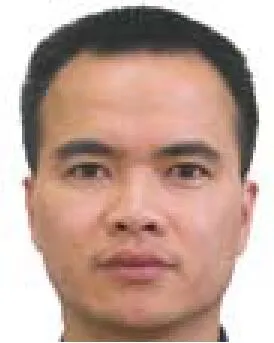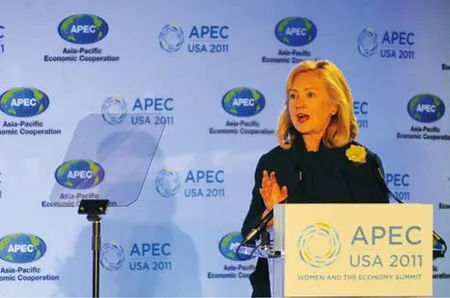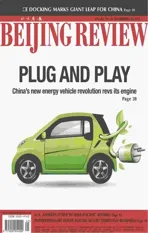Washington Looks to the East
2011-10-14ByCHENXIANGYANG
By CHEN XIANGYANG
Washington Looks to the East
By CHEN XIANGYANG
The United States appears poised to use the Hawaii APEC Summit to bolster its presence in the Asia Pacific

The United States will host the 19th APEC Economic Leaders’ Meeting in Honolulu, Hawaii, on November 12-13. The 21-member APEC is a premier forum for facilitating economic growth,cooperation, trade and investment in the Asia-Paci fi c region.
This summit is aimed at building a“seamless regional economy.” It will focus on three topics: strengthening regional economic integration and expanding trade;promoting green growth; and expanding regulatory cooperation and advancing regulatory convergence.
Expectations
The United States holds great expectations for this summit, and has been preparing for it for a long time. Predictably, U.S.President Barack Obama will be the dominant fi gure at the meeting.
Why is the United States attaching so much importance to the meeting? This is the first time the United States has hosted the APEC Summit since 1993 when the Fifth APEC Summit was held in Seattle. But this is not the main reason. The main reason is this summit carries extraordinary signi fi cance for the U.S. Government.
Although three years has passed since the global fi nancial crisis broke out in September 2008, the United States has yet to escape its impact. The U.S. economy remains sluggish,with weak GDP growth and an unemployment rate up to 9.1 percent. Currently, its government debt and fiscal deficit remain high. To boost the economy has become Obama’s top priority. Whether he can succeed in this task will directly determine his political career in the 2012 presidential campaign.
Against this backdrop, the United States has paid special attention to cementing economic ties with other countries. One of its major focuses is the Asia-Paci fi c region,which is enjoying the most rapid growth across the globe. Currently, APEC economies account for 43 percent of global trade and 55 percent of global GDP. With a market of 2.7 billion consumers, they purchase 58 percent of U.S. exported goods. Of the 15 biggest trade partners of the United States,seven are APEC members. Of course, the United States will make the most of this summit to satisfy its strategic needs.
Recently, U.S. Secretary of State Hillary Clinton has been active in promoting this summit. She published an article titled America’s Pacific Century in theForeign Policymagazine of October 11, 2011. Then,she delivered four consecutive speeches on U.S. economic strategy.
The United States sees great value in this upcoming summit partly because it intends to forcefully promote the establishment of a Free Trade Area of the Asia Paci fi c through hosting this summit, so as to counterbalance regional cooperation in East Asia.
In order to prevent the United States from being excluded from East Asian cooperation, after this APEC Summit, Obama will attend the East Asia Summit in Indonesia on November 19. It will be the fi rst time for him to attend this event.
Moreover, the United States plans to make use of this summit to seek dominance in the Asia-Paci fi c region in keeping with its strategy of “return to Asia.” It also intends to take the lead in building a new Asia-Pacific economic cooperation framework by pushing for the Trans-Paci fi c Strategic Economic Partnership Agreement(TPP) at the summit.
All these economic measures, coupled with security cooperation with its allies, are designed to enhance the U.S. strategic in fl uence in the Asia-Paci fi c region.
Launched in 2006 by Singapore, New Zealand and Chile with the aim of promoting regional economic cooperation, the TPP currently includes nine members:Australia, Brunei, Chile, New Zealand, Peru,Singapore, Viet Nam, the United States and Malaysia.
The United States is striving to sign preliminary agreements with the other eight TPPmembers or even more countries. Through the so-called “high-standard TPP,” it aspires to restructure the current East Asian regional economic cooperation mechanism and build a new Asia-Paci fi c economic order led by the United States.Given the drastic changes in the Asia Pacific, it will definitely be difficult for the United States to realize its ambitions of ensuring U.S. dominance in the region while saving its economy

OUTLINING STRATEGY: U.S. Secretary of State Hillary Clinton gives a keynote speech at the APEC Women and the Economy Summit in San Francisco on September 16

PROTESTING:South Koreans rally against the U.S.-South Korean Free Trade Agreement in Seoul on October 15
“Our hope is that a TPP agreement with high standards can serve as a benchmark for future agreements—and grow to serve as a platform for broader regional interaction and eventually a free trade area of the Asia Paci fi c,” said Clinton in her article America’s Paci fi c Century.
The Americans believe trade agreements need to include strong protection for workers, the environment, intellectual property,and innovation. The free fl ow of information technology and the spread of green technology should also be promoted, Clinton said.
Adjustments
The U.S. enthusiasm for the APEC Summit provides evidence of Washington’s global strategy adjustments. In order to adapt to changes at home and abroad in the postfinancial crisis period, the United States is modifying its foreign strategies by pursuing two major shifts.
First, the United States is striving to shift the focus of its foreign policy from national security to economy. It emphasizes diplomacy should help reinvigorate the U.S.economy, expand exports and increase employment.
The U.S. emphasis on the economic work of APEC is in keeping with its broader commitment to elevating economic statecraft as a pillar of American foreign policy, Clinton said. Economic progress depends on strong diplomatic ties, and diplomatic progress depends on strong economic ties.
“A focus on promoting American prosperity means a greater focus on trade and economic openness in the Asia Paci fi c ... As we strive to meet President Obama’s goal of doubling exports by 2015, we are looking for opportunities to do even more business in Asia,” said Clinton.
In 2010, U.S. exports to the Paci fi c Rim totaled $320 billion, supporting 850,000 American jobs.
Second, the United States is trying to shift its geopolitical focus from the Greater Middle East, which covers West Asia and South Asia, to the dynamic Asia-Pacific region. Based on this thinking, it will host a high-profile APEC Summit, participate in the East Asia Summit, and use smart power extensively in the Asia-Paci fi c region.
On the one hand, it will play a leading role in maritime issues and other Asia-Paci fi c security issues with its military supremacy in the region. On the other hand, it will make up for its inadequate economic presence in the region, especially in East Asian regional cooperation. Through this, it aims to ensure U.S.dominance in the Asia Paci fi c while saving its economy.
The two major shifts are shown clearly in an economic and foreign policy speech of Clinton in New York City on October 14.
Economic statecraft must be at “the heart” of U.S. foreign policy, said Clinton.
“As we end the war in Iraq and begin bringing troops back from Afghanistan, we are making an important pivot. The world’s strategic and economic center of gravity is shifting east, and we are focusing more on the Asia-Paci fi c region,” Clinton said.
The United States is not only a resident military and diplomatic power in Asia, but also a resident economic power, said Clinton.
All her statements prove the United States will make every effort to return to the Asia Paci fi c. But it wants more than a return.It aims to seek dominance in the region. But given the drastic changes in the Asia Paci fi c,it will definitely be difficult for the United States to realize its ambitions.
The author is deputy director of the Institute of World Political Studies at the China Institutes of Contemporary International Relations
